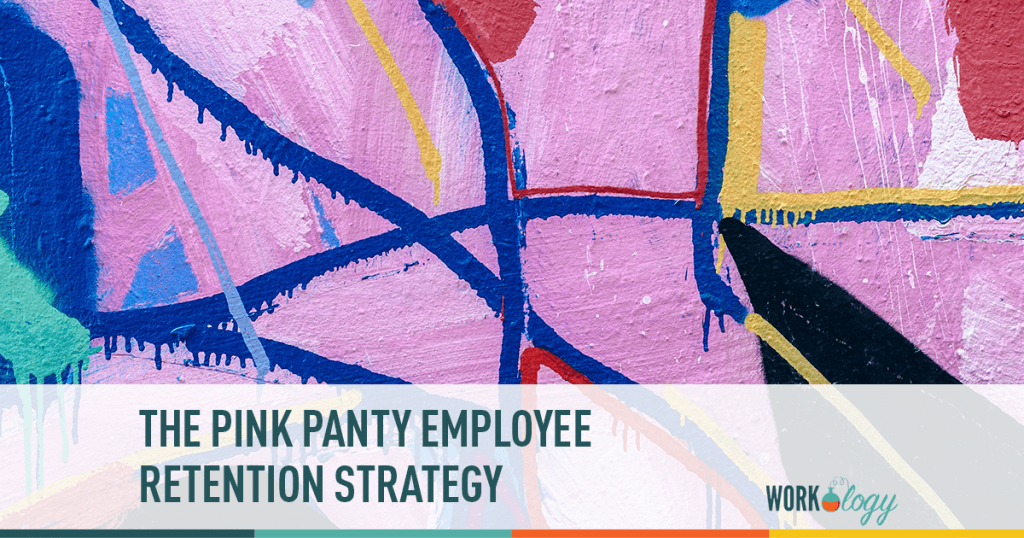When High Turnover Job Rates Create Office Dirty Laundry
Is your organization firing or letting employees go like it’s out of style? Are employees being walked out the door more often than you change your own underwear? If so, you’ve entered the pink panty employee retention strategy zone.
First off, let’s hope that you change your underwear on a regular basis say seven times or more a week. You do? Great! I’m relieved. Second, if you’re department or region has employees dropping like flies, voluntarily or involuntarily, you’re a pink panty employee retention strategy wearing member.
Do Quotas and Management Create a High Job Turnover Rate?
It’s likely that HR is not the root of the employee turnover problem.
In my last corporate gig, I worked as an HR Director for a sales division working with both inside and outside sales groups. Everyone except for support staff was tied to monthly and quarterly quotas. And because of this, it was easy to make the call when someone wasn’t cutting the mustard and meeting their quota expectations. It was easy on the surface. Except that it wasn’t.
At the end of every sales quarter, managers would make the move for termination normally a couple days before quarter’s end. Voluntarily turnover would also increase during this time since most people who were on performance improvement plans didn’t like to be canned. Working in a sales focused environment is relatively black and white, but if you’re region’s not making sales numbers, it’s not exactly a very cheerful place.
Research the Employee Turnover Statistics
I began tracking terminations and evaluating the percentage of turnover directly to front line managers, sales directors, and even regional directors. I didn’t like the aloofness from my managers and the lack of accountability or responsibility when it came to their team member’s termination. While my team was responsible for the recruiting and candidate selection process, I didn’t have the final say in which candidates received job offers. While my team was also responsible for new hire and onboarding, we weren’t directly involved in the employee training beyond employee manuals, sexual harassment, and the onboarding and training evaluation that we conducted for each and every new hire.
These managers were directly responsible for their employee turnover and retention and yet they were not measured or held accountable for these metrics. While as a HR organizational leader, I, in fact was. It didn’t make sense.
And so I number crunched, evaluated turnover metrics by manager, and presented my findings. Immediately, I was met with resistance because no regional sales manager likes to hear that their star player had a 75% turnover ratio. Every quarter, I continued to present my findings. And every quarter these card carrying members of the pink panty employee retention resistance policy party (aka the pink panty employee retention strategy zone members), continued to pass the buck.
Reduce a High Employee Turnover Rate; Not Always Easy
While I’d like to paint a pretty picture for you, I can’t. Employee turnover and retention didn’t change the way I hoped. While I did affect employee turnover by nearly 25% through some employee surveys and other employee engagement programs, it really didn’t matter. Because as an HR professional, I am not directly responsible for and managing these teams.
The failure of employee retention lay in my organization and that it was not set up to ensure my employees were set up for success. HR wasn’t set up for success either. The failure of the employee retention policy was that my managers were not held accountable and their bonuses were tied only to their performance quotas and not their team’s turnover and employee retention data.
If you liked this post, then you might enjoy The Candidate Anti-Engagement Strategy.









2 Comments
Great post, Jessica. Especially the title! 🙂 I think this is very common in sales divisions. In a previous life I was an outside b2b sales rep and it was highly stressful. My manager’s favorite saying was “From hero to zero” every first of the month. The entire attitude, culture, mindset (choose the word) was centered around that phrase and the fact that no matter what you sold last month, it was irrelevant as of today, the 1st. This certainly didn’t come from HR. I couldn’t even tell you who HR was or if I ever met them, though I must have when I was hired I suppose.
When it was time for potential turnover, which occurred pretty regularly now that I think about it, if a rep was having a rough few months but had previously been a great performer, it was desperate retention strategy time for the manager. This was only because the manager knew the rep COULD sell and needed him/her TO sell in order to meet his/her numbers. Other than that, the message loud and clear was produce or move on, and if you’re producing, your paycheck better be enough to keep you here. If you’re not producing, well, there’s the door and I’ll get someone on my team who will perform. I don’t think I ever had a manager who was responsible for any numbers that didn’t revolve around production. I don’t think there was consideration for the cost of turnover, training, onboarding or any of the factors that make it so expensive to lose/fire an employee. And it is ridiculous that HR would be held accountable for that. Your last paragraph is a great summary of how costly it can be to have an organization set up this way, because it is set up for failure.
Thanks Jen. I wonder how many organizations or if companies hold their managers and teams accountable to turnover. My thought is no. That’s HR’s area right? WRONG.
I’d love to hear from some folks who do this and how it works for them. . .
JMM
Comments are closed.